The market has been volatile recently, and sentiment has fallen into extreme panic. But just a few days ago, DoubleZero Foundation announced that it had received a $28 million investment led by Dragonfly and Multicoin Capital. This news quickly attracted attention. What is so unique about DoubleZero that it has attracted capital in the current sluggish market environment?
Just yesterday, DoubleZero founder Austin Federa went on the New York Stock Exchange (NYSE) TV live broadcast to talk about how Double Zero is revolutionizing Internet infrastructure, but Twitter crashed during the live broadcast.
He joked in a tweet that it was like the universe had given them a "perfect product demo." The tweet was a tongue-in-cheek suggestion that there was indeed a bottleneck in the current Internet infrastructure, and Double Zero might be the solution.
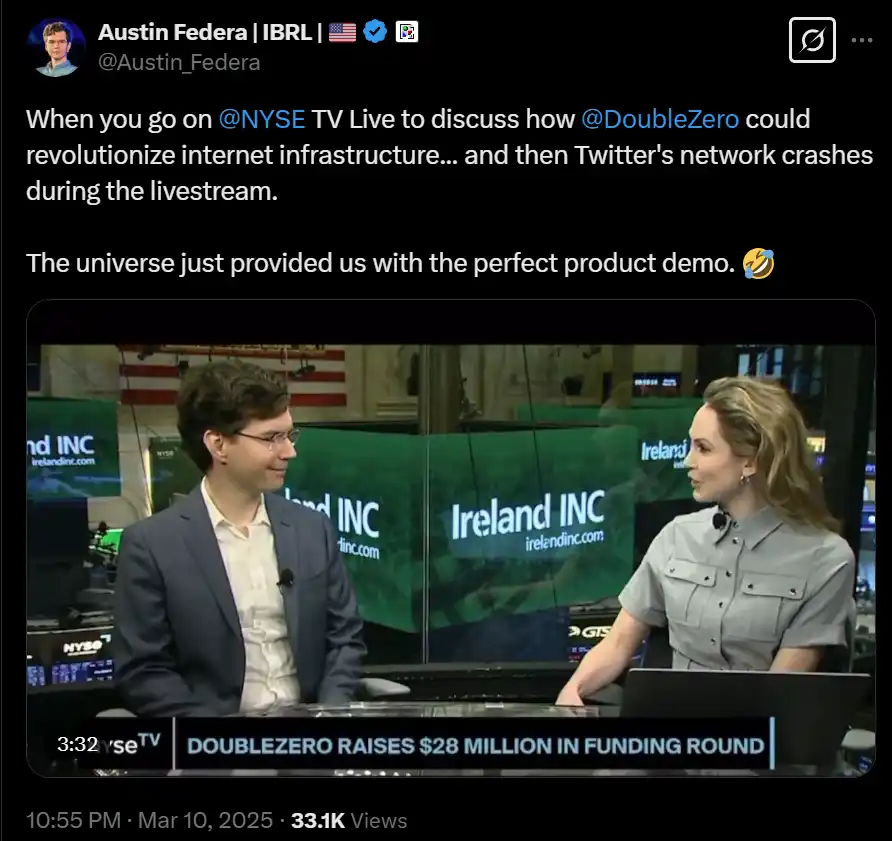
Double Zero: A dark horse in DePIN
Double Zero is a project based on the DePIN track, allowing anyone to contribute independent fiber optic links without permission, which is equivalent to laying an "information highway" for the Web3 world. The biggest highlight of the project is its hardware-driven attributes, directly targeting the infrastructure layer. DoubleZero's goal is simple: to increase bandwidth and reduce latency for all high-performance blockchains.
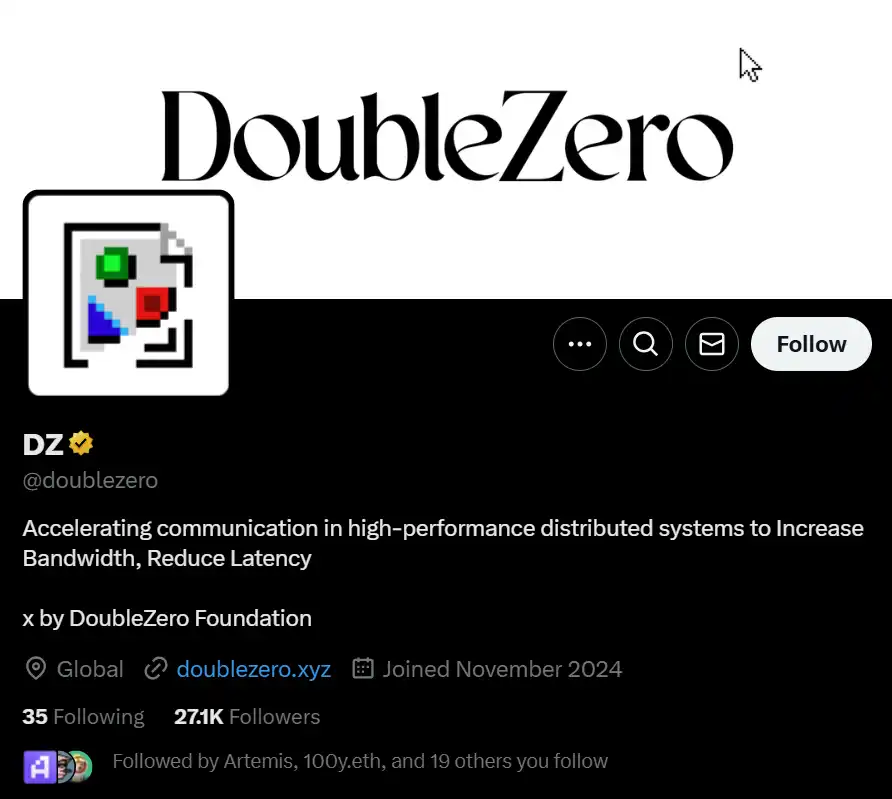
The project has quickly attracted industry attention with its unique technical vision and high-profile team background, and is regarded as one of the important narratives in the Solana ecosystem and DePIN field.
Solana "veteran" Austin Federa leads the team, Double Zero has its own aura
If a project wants to stand out, it not only needs technical strength, but also a core figure who can mobilize resources and promote the narrative. One of the reasons why Double Zero attracted market attention as soon as it debuted is its chief founder - Austin Federa.
Those who are familiar with the Solana ecosystem must be familiar with him. He was the Head of Strategy of the Solana Foundation and can be said to be one of the important driving forces behind the early rise of the Solana ecosystem. He has a deep relationship with the Solana core team (including Anatoly Yakovenko and Raj Gokal). It is this relationship that enabled Double Zero to obtain resource support and market recognition from the Solana ecosystem in the early stage.
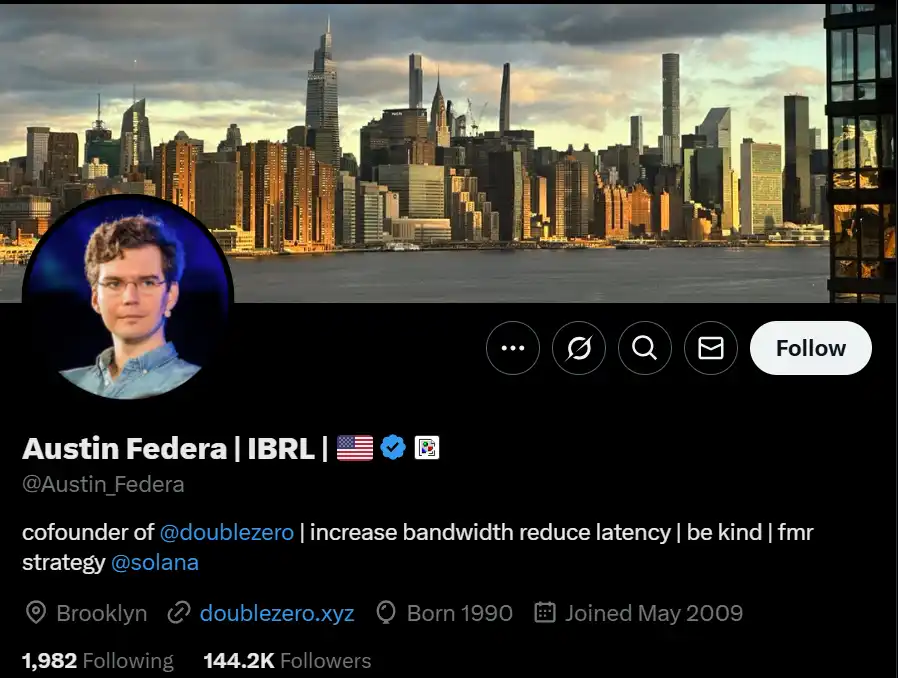
During his time at the Solana Foundation, he was not only responsible for global market strategy, but also directly participated in the implementation of several key projects, such as promoting the integration of USDC and USDT on Solana, and even deeply involved in the ecological cooperation in the FTX era. In other words, Austin played an important role in Solana's growth from an emerging public chain to an industry giant.
Now, Austin has stepped out of Solana and personally managed Double Zero with his experience, connections, and deep understanding of blockchain. This not only put Double Zero at a higher starting point, but also instantly raised the market's expectations for this project.
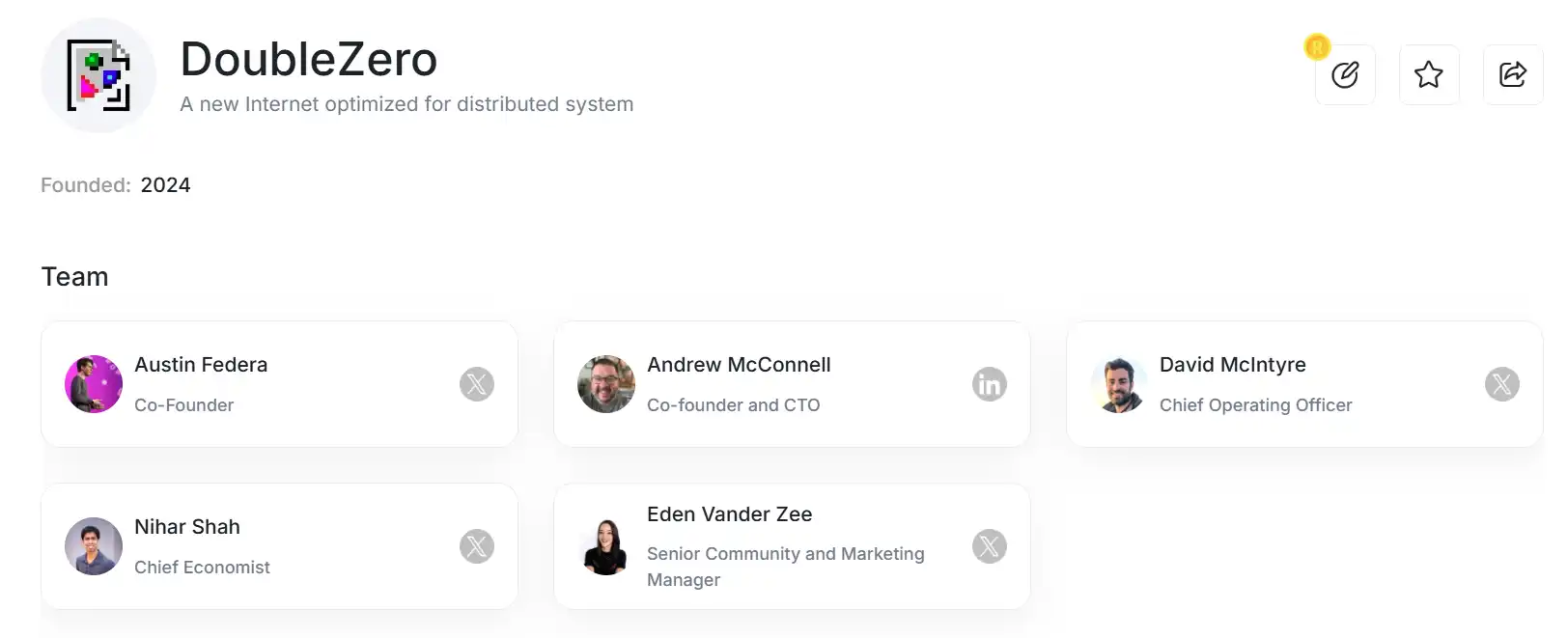
From the perspective of technical vision, Double Zero and Solana are also of the same lineage, and some even regard Double Zero as "an important puzzle piece of Solana's DePIN narrative." Rather than saying that Double Zero is an independent DePIN project, it is better to say that it is a "field upgrade" of Solana in the field of de-DePIN.
The new darling of the capital market
If you are familiar with the investment landscape of the crypto community, you will know the great influence of Dragonfly and Multicoin. They are not only long-term supporters of the Solana ecosystem, but also play an important role in multiple key projects (such as Multicoin's early bet on Solana and Dragonfly's participation in Serum).
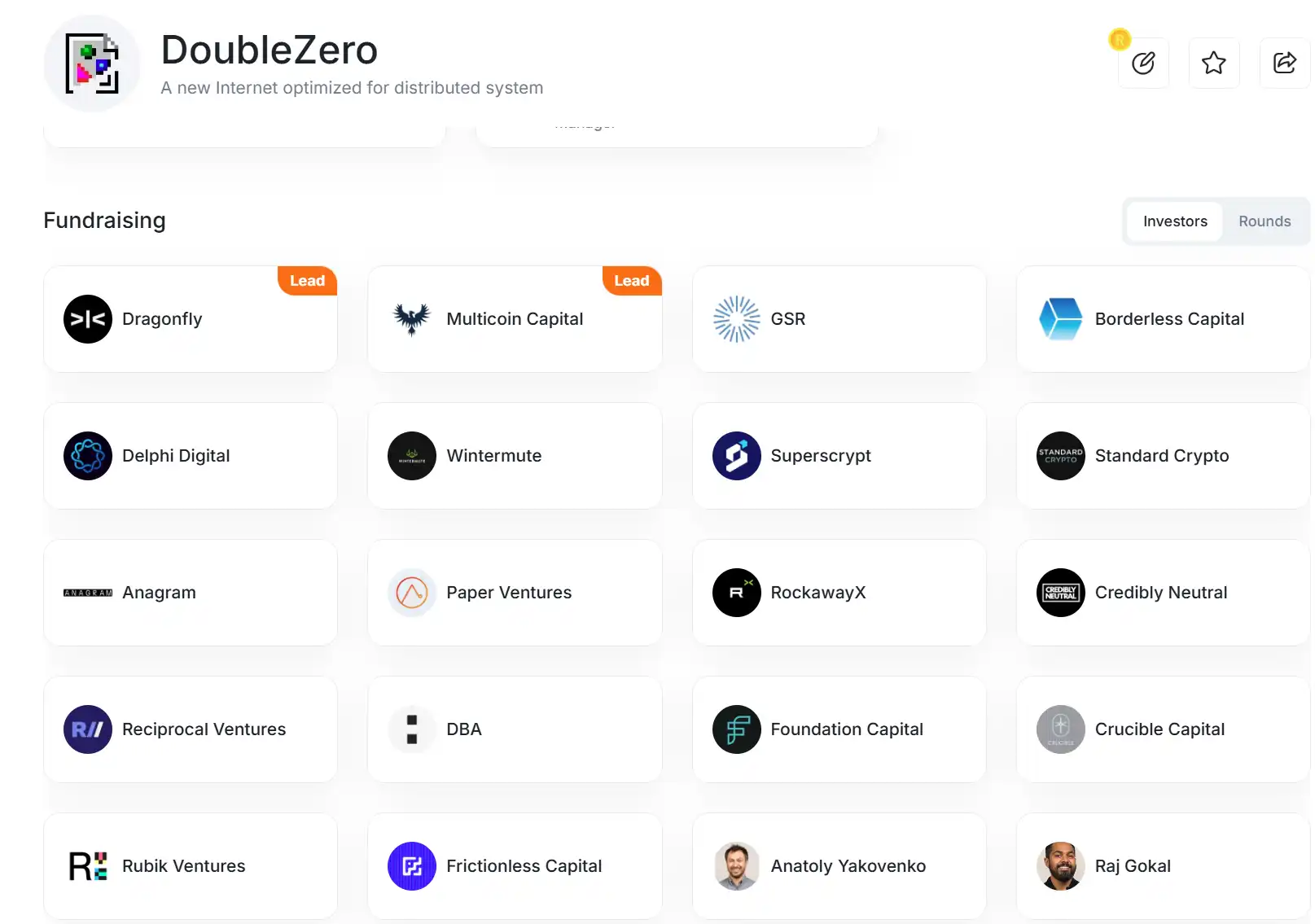
In addition to the top VCs, financial forces within the Solan ecosystem also played a core role in this round of financing. Anatoly Yakovenko and Raj Gokal, co-founders of Solana Ventures and Solana Labs, also participated as angel investors. What does this mean?
Solana officials personally came out to support, Austin did not fight alone, but brought the entire Solana resource pool into the market, a comprehensive tilt of funds, technology, and market resources. For the entire DePIN track, this is undoubtedly an important signal: the Solana ecosystem is actively deploying a physical infrastructure network, and Double Zero may be the "vanguard" leading the charge.
Technical Highlights: Is the Dual-Ring Architecture a Super Accelerator?
The DoubleZero network optimizes blockchain systems through two key improvements: First, it reduces the burden on validators by pre-filtering incoming junk and duplicate transactions through dedicated hardware, allowing blockchains to share filtering resources without requiring each validator to provide them individually. Second, it improves communication efficiency through clear message routing, tracking, and priority management.
The outer ring connects to the public Internet and uses hardware (such as FPGA) for attack protection, signature verification, and transaction filtering; the inner ring processes this filtered traffic through dedicated bandwidth lines and builds consensus.
The core technical highlight of Double Zero lies in its unique Two-Ring Architecture. The Outer Ring connects to the public Internet and uses hardware (such as FPGA) for attack protection, signature verification and transaction filtering. The Inner Ring processes the filtered traffic through a dedicated bandwidth line and builds consensus.
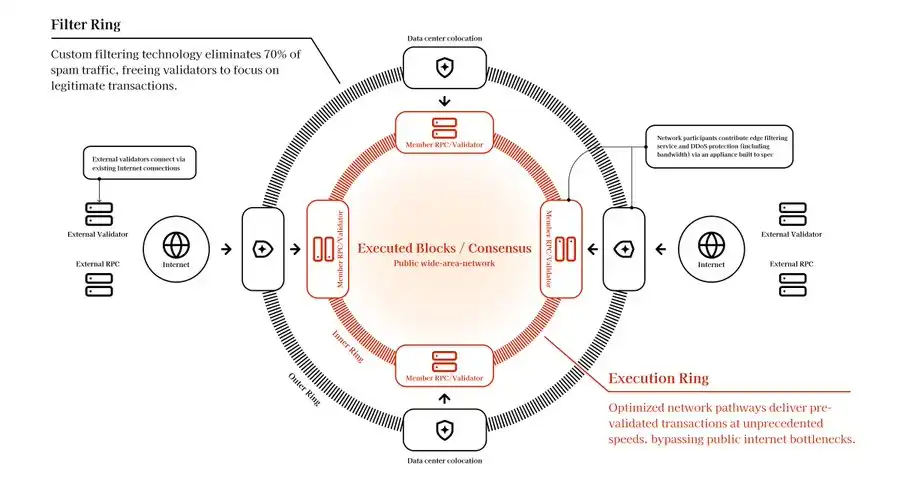
As the first line of defense, Outer Ring is mainly responsible for filtering invalid traffic such as spam transactions, DDoS attacks, and malicious contract calls. It uses an adaptive traffic filtering mechanism, machine learning, and heuristic rules to analyze transaction patterns in real time, accurately identify and intercept malicious traffic, and ensure that only valid transactions can enter the blockchain mainnet.
At the same time, the Outer Ring also relies on decentralized zero-permission fiber contributions, and independent contributors in the network provide physical infrastructure to further ensure the authenticity and priority of data packets. Before entering the Inner Ring, all transactions must undergo basic validity screening in the Outer Ring to reduce invalid transactions entering the core network and improve overall processing efficiency.
Transactions entering the Inner Ring are strictly screened, so it can focus on efficient transaction processing. The Inner Ring uses a high-performance architecture similar to Solana, supports ultra-high TPS (transactions per second), ensures extremely short transaction confirmation time, and can cope with the needs of large-scale transactions.
In order to further improve the smoothness of the network, Double Zero also adopts a stateless verification mode. This lightweight transaction processing method makes the entire network run more smoothly and efficiently compared to the state storage mode of traditional blockchains.
Advantages over traditional Layer 1 and Rollup solutions
Compared with traditional Layer 1 and Rollup solutions, Double Zero has shown significant advantages. First, through the pre-filtering of the Outer Ring, Double Zero effectively reduces the impact of junk transactions, reduces the risk of block congestion, and avoids the inefficient Mempool queuing method of public chains such as Ethereum. Unlike the Rollup solution, Double Zero independently optimizes the network layer, eliminating the waiting of the batch processing cycle, significantly speeding up the transaction confirmation speed, and avoiding unnecessary delays.
As Kyle Samani, managing partner of Multicoin Capital, said: "Due to public Internet bandwidth limitations and non-deterministic routing, it is impossible to achieve a smooth Web2-like experience without resolving the latency issues between validators." - This is exactly the mission of Double Zero.
















